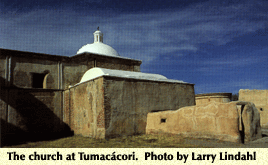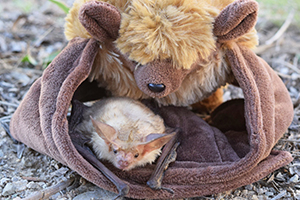Southern Arizona In Hispanic Times
by James E. Officer, Emeritus Professor of Anthropology, University of Arizona
from sonorensis, Volume 16, Number 1 (Spring 1996)
During the years of Spanish and Mexican control, Southern Arizona was, for the most part, included within a larger area which the Spaniards called the "Pimería Alta" or "Land of the Northern Pimans (O'Odham)." European explorers passed through the Pimería Alta as early as the middle of the sixteenth century, but two-hundred years elapsed before Spanish colonists came to live in what is now Southern Arizona.
 By the time Hispanic settlers arrived, the native population had become familiar with a few elements of European culture, thanks to visitations from Jesuit missionaries beginning with Father Eusebio Francisco Kino in 1691. In some communities along the Santa Cruz and San Pedro rivers the Indians were growing European-derived grains, vegetables and fruits. These cultigens supplemented native crops such as corn, beans and squash. Stock raising, another contribution of the priests, was present at some locations, but herds were small.
By the time Hispanic settlers arrived, the native population had become familiar with a few elements of European culture, thanks to visitations from Jesuit missionaries beginning with Father Eusebio Francisco Kino in 1691. In some communities along the Santa Cruz and San Pedro rivers the Indians were growing European-derived grains, vegetables and fruits. These cultigens supplemented native crops such as corn, beans and squash. Stock raising, another contribution of the priests, was present at some locations, but herds were small.
Southern Arizona's first Hispanic colonists were probably individuals who came into the area looking for minerals. In 1736, a major silver strike took place a few miles southwest of modern Nogales, Sonora, and some of the prospectors pushed on northward. By the middle of the 18th century Spaniards were living near the mission communities of Guevavi, Tumacácori, Arivaca and Sópori, where they operated small mines, raised livestock and did some farming.
 In the late fall of 1751, many of the Pima Indians revolted against the priests and settlers. Over a period of three months, they martyred two of the Jesuits and killed numerous Spanish colonists and a few Christianized Indians who worked for them. As a result of the revolt, Spanish authorities in 1752 established a military post (presidio) at Tubac, the first concentrated Spanish settlement in Arizona. Although it was a rebellion of the Pima Indians that led to this decision, the soldiers stationed at Tubac soon found themselves fighting Apaches and Seris, not Pimas.
In the late fall of 1751, many of the Pima Indians revolted against the priests and settlers. Over a period of three months, they martyred two of the Jesuits and killed numerous Spanish colonists and a few Christianized Indians who worked for them. As a result of the revolt, Spanish authorities in 1752 established a military post (presidio) at Tubac, the first concentrated Spanish settlement in Arizona. Although it was a rebellion of the Pima Indians that led to this decision, the soldiers stationed at Tubac soon found themselves fighting Apaches and Seris, not Pimas.
The uprising of 1751 and the increase in Apache raiding which began shortly afterward, led to the abandonment of isolated mines and ranches throughout much of the Pimería Alta. For the next half century, most of the Hispanic population of the region chose to live in, or on the outskirts of, the widely-scattered military posts.
For Spanish settlers in Southern Arizona, the major events of the late 18th century were the Jesuit Expulsion of 1767 and the transfer of the Tubac military garrison to new quarters at Tucson in 1776. Franciscan missionaries soon came in to replace the Jesuits and Tumacácori, rather than Guevavi, became their principal headquarters. Its proximity to Tubac made it safer for priests and local Indians alike.
In the years following transfer of the presidio to Tucson, the Hispanic population of Tubac declined to a handful of settlers. However, the community received a new lease on life in 1787 when a garrison composed of O'Odham soldiers and Spanish officers occupied the site.
A new Spanish Indian policy, initiated in the 1780s, led to relative peace between the Apaches and others during the closing years of Spanish rule. Hispanic settlers in the early 1800s went back to such pursuits as mining and ranching. In 1812 don Agustin Ortiz received title to a substantial land grant in the Arivaca area, the first to be awarded so far away from any military post.
Spanish soldiers from the Tucson and Tubac garrisons were called upon to help put down the Mexican insurgency beginning in 1810 and their absence from the presidios reduced the Hispanic population somewhat. However, they were back on duty in Southern Arizona by the time Mexico gained independence in 1821.
During the next few years, small-scale mining continued at such locations as the Santa Rita and Sierrita Mountains, and on the slopes of Mt. Benedict northeast of Nogales. Prominent Sonoran families sought and obtained titles to land grants in the San Pedro, Santa Cruz and Babocómari river valleys where they began livestock operations of greater magnitude than any seen previously in the area. After 1835, however, both ranching and mining declined as a result of greatly increased Apache raiding. Once again, the small Hispanic population of Southern Arizona concentrated itself in or near the presidios of Tucson and Tubac.
When the U.S.-Mexico War began in 1846, the missionary priests were gone, and San Xavier del Bac and Tumacácori were the only O'Odham villages along the Santa Cruz River. The Gila River communities were still in place, and Tohono O'Odham continued to inhabit desert villages southwest of Tucson; but no members of the Piman linguistic group had resided in the San Pedro Valley for seventy-six years. Overall, the O'Odham population was much diminished. This decline, many scholars believe, was primarily due to their lack of resistance to Old World diseases.
Apache attacks forced the abandonment of both Tubac and Tumacácori in December of 1848, and by the time Southern Arizona became a part of the United States in 1854, Tucson was the only Hispanic community in the region. Nearby San Xavier del Bac was the sole remaining O'Odham village on the Río Santa Cruz.
The natural environment of Southern Arizona at the time of the Gadsden Purchase was probably little changed from that which Father Kino encountered in 1691. The local Hispanic settlers accomplished much less in exploiting such resources as minerals, farm lands and pasturage than did their counterparts farther south in Sonora. Apache raiding and warfare were major factors in limiting population growth in the Pimería Alta and forcing its concentration near the military posts.










